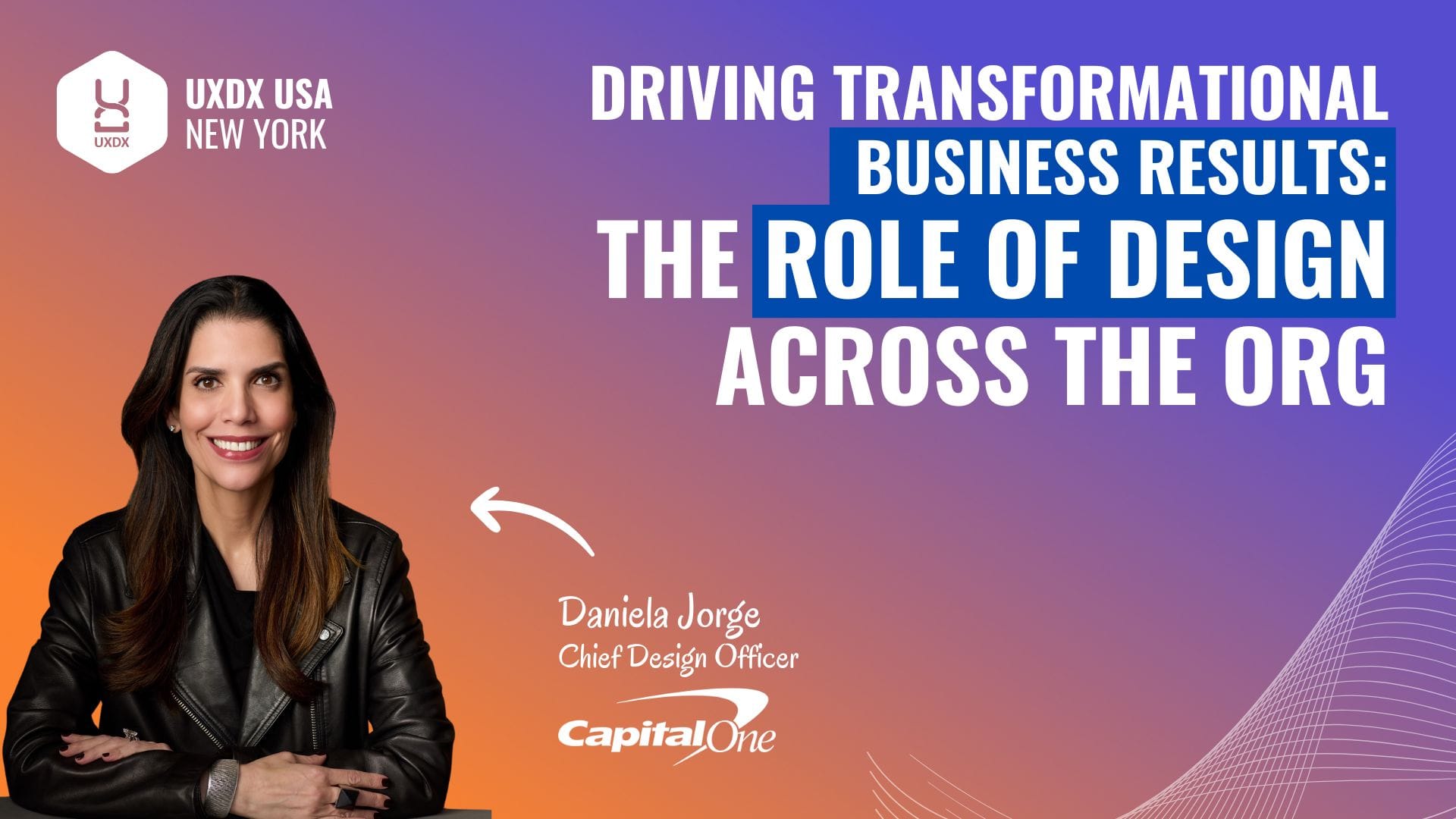Driving Transformational Business Results: The Role of Design Across the Org

“We all get into design to create for people. But when you start your first job, you quickly realise no one prepared you for how to design with people.”
That candid observation from Daniela Jorge, Chief Design Officer at Capital One, set the tone for her fireside chat with Alex Burke, CEO of Optimal, at UXDX USA 2025. Their conversation, Driving Transformational Business Results: The Role of Design Across the Org, was a masterclass in how design leadership extends far beyond screens, pixels, or journeys. And into alignment, strategy, and authentic leadership.
The Shift from Designing For to Designing With
Early in the session, Jorge reframed one of the biggest challenges designers face in corporate environments: collaboration. While design education emphasises creating for users, few programmes teach the skills required to co-create effectively with colleagues in engineering, product, risk, or legal.
She compared it to planning dinner with a group of friends. Everyone wants to eat, but individual preferences, dietary restrictions, and moods pull in different directions. Similarly, in multidisciplinary teams, alignment doesn’t just happen as it must be cultivated.
Jorge emphasised applying the same empathy and curiosity designers bring to user research to the people they collaborate with. Understanding colleagues’ motivators, pressures, and goals makes it easier to find common language and shared success.
Defining Success Before Design
One of Jorge’s most powerful insights came when she reflected on what makes design work stick in complex organisations. The key, she said, lies in aligning teams on the problem and the success criteria before diving into design solutions.
She recalled leading a redesign of a company’s mobile app. The interface had grown cluttered and confusing, but the business also had a goal: introducing customers to more features. By anchoring the redesign to that specific outcome (helping customers discover more products) Jorge’s team could make confident design recommendations and measure success clearly.
“When everyone agrees on what success looks like,” she noted, “there’s far less room for subjective debates about what’s ‘better’ or ‘worse’ in the design.”
A Seat at the Table: Earned, Not Assigned
The conversation turned to one of the most debated topics in design: securing “a seat at the table.” Jorge’s perspective was refreshingly grounded. She argued that influence doesn’t come from a title or the abstract notion of “design” being represented in leadership meetings. Instead, it comes from individuals showing up with expertise, business acumen, and clear contributions.
“When people invite me into discussions, it’s not because they need a designer in the room. It’s because they want my perspective.” she explained.
For designers aspiring to leadership roles, this shifts the focus. Rather than fighting for collective recognition, it’s about consistently demonstrating value as individuals who can bridge design and business.
Choosing Leadership: From Designer to Enabler
Jorge’s journey into management began early. She recognised that some of the most talented designers around her struggled to get their ideas heard, not because their designs lacked quality, but because they lacked the ability to communicate, align stakeholders, and pitch effectively.
She decided to step into leadership to create an environment where those designers could thrive. “I realised my role could be helping others’ ideas succeed,” she said.
Her curiosity about how businesses work, and her willingness to engage in discussions beyond design, also accelerated her path into senior leadership. Over time, she became known not just as a design leader, but as a business leader with a design background.
Leading Through Relationships and Candour
Asked to reflect on her leadership style, Jorge pointed to two principles: building authentic relationships and “saying the thing.”
Strong relationships make it easier to collaborate, share candid feedback, and advocate for design at the right moments. She described how knowing colleagues personally allows her to send quick, informal messages that open doors for her team; conversations that would be far harder without trust already in place.
“Saying the thing,” meanwhile, is about naming the elephant in the room. Whether it’s misaligned goals or an unspoken tension, Jorge believes in surfacing issues directly but respectfully. Design facilitation skills, she noted, help teams not just identify problems, but realign and move forward together.
Storytelling with an Audience-First Lens
Though she modestly admitted she doesn’t consider herself a “great storyteller,” Jorge pointed out that design training naturally develops audience awareness. Every presentation, strategy, or pitch is crafted with the listener in mind like executives, peers, or teams.
Burke, reflecting on his own career, agreed. From television production to his current CEO role, storytelling and clarity of message remain fundamental. Both leaders underscored that whether you’re designing a product, presenting a vision, or convincing investors, effective storytelling shapes outcomes.
Strategy as an Outside-In Process
When the conversation shifted to strategic planning, Jorge described Capital One’s “outside-in” approach. Rather than starting with internal assumptions, they first scan the external landscape: market trends, technology shifts, and lessons from “beacon” companies.
From there, they identify points of highest leverage for their organisation and explore divergent “what if” scenarios before converging on a recommendation.
In design, she often employs methods like prototypes or “working backwards” press releases to create a compelling vision, then maps the steps required to realise it. This balance of creativity and discipline ensures strategies are both aspirational and executable.
Navigating Priorities and Roadblocks
In a company as large as Capital One, with 50,000 employees, competing priorities are inevitable. Jorge explained that her biggest challenge isn’t deciding what to do, but what not to do.
She focuses her personal involvement on a few initiatives where design can be a true point of leverage, while ensuring her team has broad coverage across other priorities. Transparency is key: she makes it clear why she’s focusing on certain areas, so others don’t feel overlooked.
She also stressed the importance of maintaining a “learning agenda.” Regular check-ins ensure projects are still aligned to agreed goals. If a pivot becomes necessary, it should be intentional and based on new information, not drift.
Turning Constraints into Creativity
One of the most compelling parts of the conversation addressed the tension between user experience and regulation in financial services. How do you balance delighting customers with mitigating fraud and complying with strict laws?
For Jorge, the answer lies in collaboration. Instead of treating risk, fraud, and legal as blockers, she invites them into the design process. Co-creating solutions with these partners not only surfaces risks early but often sparks more innovative approaches.
“The most constrained situations can be the most creative,” she said.
Staying Authentic in Leadership
When asked about growing into leadership roles, Jorge highlighted authenticity. Leaders, she argued, don’t need to conform to a single archetype. As an introvert, she leaned into her own strengths rather than trying to perform extroversion.
“People pick up when you’re not being authentic,” she said. “The most effective leaders are those who stay true to themselves.”
Key Takeaways
The fireside chat left the audience with practical and relatable insights into how design leadership creates impact in large organisations:
- Design with people, not just for them. Curiosity about colleagues is as vital as curiosity about users.
- Define success early. Align on the problem and metrics before designing solutions.
- Earn influence individually. Business acumen and authentic contributions matter more than titles.
- Lead through relationships and candour. Trust and transparency unlock alignment.
- Co-create within constraints. Bringing risk and compliance partners into the process sparks better outcomes.
Ultimately, Jorge’s message was clear: transformational design isn’t just about artefacts or outputs. It’s about relationships, strategy, and authenticity. When design leaders lean into those, they become catalysts for business results.
